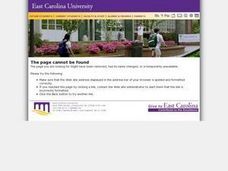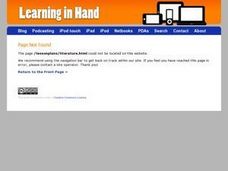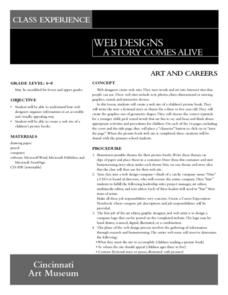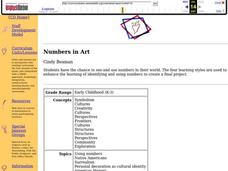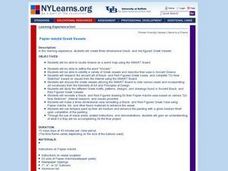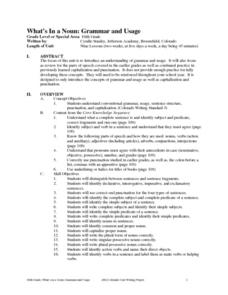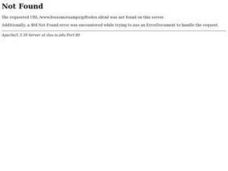Curated OER
Illinois Wild
Sixth graders identify different animals native to Illinois. They research a specific animal to study more about its characteristics, examine what makes a habitat, and recognize the difference between a food web and food chain.
Teach Engineering
Quantum Dots and the Harkess Method
The Fantastic Voyage is becoming close to reality. The class reads an article on the use of nanotechnology in the medical field and participate in a discussion about what they read. The discussion method helps class members become more...
Nuffield Foundation
Observing Osmosis, Plasmolysis, and Turgor in Plant Cells
Create the perfect conditions for osmosis. Young scholars use a microscope to observe plant cells exposed to distilled water or sodium chloride. They observe how osmosis creates turgid or plasmolyzed cells.
National Woman's History Museum
Getting with the Program
A seven-step lesson introduces the emergence of computer sciences and the contributions women made to the profession after World War II. Several science experiments offer pupils a hands-on learning experience that showcases parabolas,...
Curated OER
Unit Perimeters and Areas
Students use Geometers SketchPad to find the area and perimeter of several shapes. In this geometry lesson, students determine area of rectangles and progress through irregular polygons. None of the referenced worksheets are included...
Curated OER
STONEHENGE
Students work in cooperative groups to create a theory about the origin of Stonehenge. Each member of the group has a specific role, responsibilities and tasks. The group work can be implemented as a scaffolding technique.
Curated OER
Chucky Chickadee: Bird and Breakfast Meet the Winter Friends
Students compare and contrast the attributes of winter birds. In this winter bird lesson, students examine the physical attributes of Black-capped Chickadees, Cardinals, Blue Jays, Flickers, Juncos, Nuthatches, and Tufted Titmouses as...
Curated OER
Paste Paper
Students watch the teacher demonstrate the process of making paste paper. They create their own wheat paste papers following the example of the teacher. Students make several pieces of paste paper, and use them to make collages.
Curated OER
The Important Thing About A Family
In this lesson students identify the ways families provide basic needs to their members. Students create and publish a booklet to display this information. This lesson is designed to have a class of older children buddy with the first...
Curated OER
Your Own Fresh Water Aquarium in the Classroom
Students explore aquariums. In this fish and ecosystems lessons, students establish a freshwater aquarium environment using materials provided. Students read about and care for the classroom fish.
Curated OER
Feelings From A to Z
Third graders express and interpret information and ideas. They identify a variety of feelings and their effect on people. They explain how someone's actions can cause someone else to have a specific feeling.
Curated OER
Gettysburg
Students investigate the major events of the Civil War by reading and depicting the Gettysburg Address. Video clips are used to create an iMovie to enhance their background knowledge.
Curated OER
Palms and Literature
Students read and analyze the Civil War novel, 'Charley Skedaddle.' They define key vocabulary terms, develop a story map, create a concept web for a character, and take vocabulary tests.
Curated OER
Web Designs: A Story Comes Alive
Students work cooperatively to choose a theme, write a story, and produce a web site to display this story in this middle-level lesson on the career of a web designer. This excellent lesson ends with an organized, web site launch party.
Curated OER
Geology Rocks
Middle schoolers discuss information relating to Illinois geology. They examine top mineral resources in Illinois to find detailed information about geodes and where they can be found. Students complete geode lab to explore external...
Curated OER
School Autobiography
Students brainstorm for fifteen minutes independently, sketching out what they remember or how they want to organize their data. they write a journal along the lines of "what do you remember about kindergarten? Write to a (fictional)...
Curated OER
Numbers In Art
Help develop an awareness of the natural and manufactured environment and relate the subject matter to young learners' lives. The interpretation of the meaning of art is reinforced and its application to self and other audiences is...
Curated OER
Papier-mache Greek Vessels
Sixth graders create three-dimensional black and red figured Greek Vessels out of papier-mache, while researching and discussing Greek history, and myths of powerful gods and goddesses.
Curated OER
SWEET DREAMS, MOON BABY
Study previously-unpublished techniques and also stunning yet surprisingly easy historic techniques in quilting. Advance from simple needleturn applique to antiquarian fancywork with optional stencil-shading applique, inkwork, and...
Curated OER
Annotated Bibliographies
What is an annotated bibliography? While not usually required until college, introducing your juniors and seniors to this type of document will prepare them for their collegiate careers. The term is defined, and the three elements of an...
Harry S. Truman Library & Museum
Harry S. Truman And Korea
Engage the class in researching oral histories and historical revision, in order to gain a greater understanding and appreciation for the sacrifices made by Americans in the Korean War. The inquiry process is scheduled to take one week....
Curated OER
What's In a Noun: Grammar and Usage
Nine lessons in a grammar and usage unit provide endless opportunities for drill and practice. Topics include the four types of sentences, subject and predicates, nouns, verbs, adjectives, pronouns, adverbs and prepositions, conjunctions...
Curated OER
Expression: Masks - Activity 1
Students create art plans for an "installation" after viewing a video of Native American mask making that centers around the Salmon rack idea. Emphasis is placed on collaborative work in this introductory lesson.
Curated OER
Sex Stereotypes in Society
Students analyze a collection of advertisements or photographs in a text or magazine and identify the stereotypes used or possible biases of the editors. They discuss how these stereotypes are formed, and the ways in which they impact...









